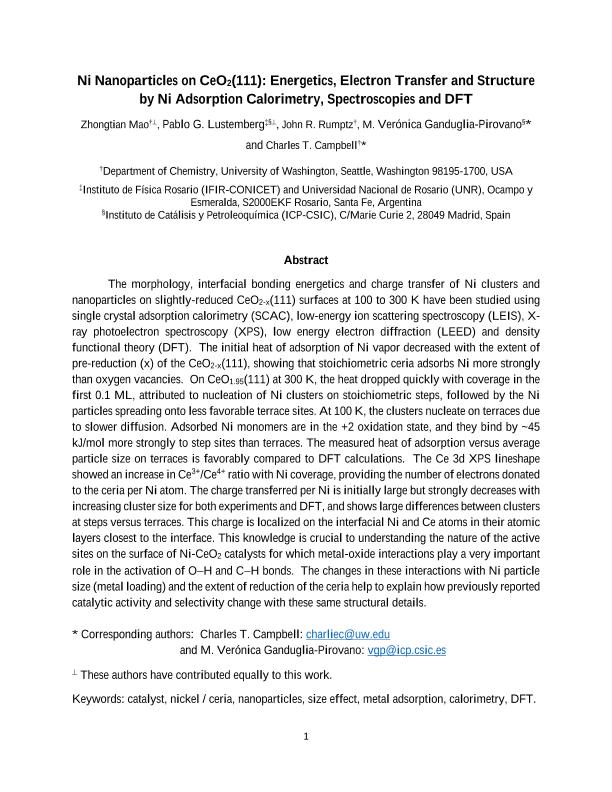Artículo
Ni Nanoparticles on CeO 2 (111): Energetics, Electron Transfer, and Structure by Ni Adsorption Calorimetry, Spectroscopies, and Density Functional Theory
Mao, Zhongtian; Lustemberg, Pablo German ; Rumptz, John R.; Ganduglia Pirovano, Maria Veronica; Campbell, Charles T.
; Rumptz, John R.; Ganduglia Pirovano, Maria Veronica; Campbell, Charles T.
 ; Rumptz, John R.; Ganduglia Pirovano, Maria Veronica; Campbell, Charles T.
; Rumptz, John R.; Ganduglia Pirovano, Maria Veronica; Campbell, Charles T.
Fecha de publicación:
05/2020
Editorial:
American Chemical Society
Revista:
ACS Catalysis
ISSN:
2155-5435
e-ISSN:
2155-5435
Idioma:
Inglés
Tipo de recurso:
Artículo publicado
Clasificación temática:
Resumen
The morphology, interfacial bonding energetics, and charge transfer of Ni clusters and nanoparticles on slightly reduced CeO2-x(111) surfaces at 100-300 K have been studied using single-crystal adsorption calorimetry (SCAC), low-energy ion scattering spectroscopy (LEIS), X-ray photoelectron spectroscopy (XPS), low-energy electron diffraction (LEED), and density functional theory (DFT). The initial heat of adsorption of Ni vapor decreased with the extent of pre-reduction (x) of CeO2-x(111), showing that stoichiometric ceria adsorbs Ni more strongly than oxygen vacancies. On CeO1.95(111) at 300 K, the heat dropped quickly with coverage in the first 0.1 ML, attributed to nucleation of Ni clusters on stoichiometric steps, followed by the Ni particles spreading onto less favorable terrace sites. At 100 K, the clusters nucleate on terraces due to slower diffusion. Adsorbed Ni monomers are in the +2 oxidation state, and they bind more strongly by ∼45 kJ/mol to step sites than terraces. The measured heat of adsorption versus average particle size on terraces is favorably compared to DFT calculations. The Ce 3d XPS line shape showed an increase in Ce3+/Ce4+ ratio with Ni coverage, providing the number of electrons donated to ceria per Ni atom. The charge transferred per Ni is initially large but strongly decreases with increasing cluster size for both experiments and DFT, and it shows large differences between clusters at steps versus terraces. This charge is localized on the interfacial Ni and Ce atoms in their atomic layers closest to the interface. This knowledge is crucial to understanding the nature of the active sites on the surface of Ni/CeO2 catalysts, for which metal-oxide interactions play a very important role in the activation of O-H and C-H bonds. The changes in these interactions with Ni particle size (metal loading) and the extent of reduction of ceria help to explain how previously reported catalytic activity and selectivity change with these same structural details.
Palabras clave:
CALORIMETRY
,
CATALYST
,
DFT
,
METAL ADSORPTION
,
NANOPARTICLES
,
NICKEL/CERIA
,
SIZE EFFECT
Archivos asociados
Licencia
Identificadores
Colecciones
Articulos(IFIR)
Articulos de INST.DE FISICA DE ROSARIO (I)
Articulos de INST.DE FISICA DE ROSARIO (I)
Citación
Mao, Zhongtian; Lustemberg, Pablo German; Rumptz, John R.; Ganduglia Pirovano, Maria Veronica; Campbell, Charles T.; Ni Nanoparticles on CeO 2 (111): Energetics, Electron Transfer, and Structure by Ni Adsorption Calorimetry, Spectroscopies, and Density Functional Theory; American Chemical Society; ACS Catalysis; 10; 9; 5-2020; 5101-5114
Compartir
Altmétricas



